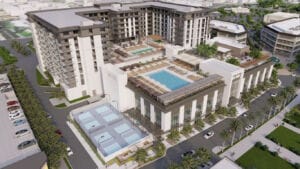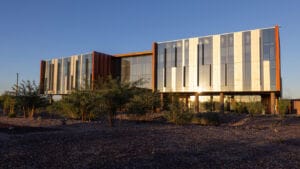If you liked commercial real estate in 2018, you’re going to enjoy 2019 just as much.
Often, sequels don’t live up to the high expectations set by their predecessors, but when it comes to the general health of the commercial real estate market in the Greater Phoenix area, another year like 2018 is very welcome.
All of the major economic signs point to another positive year for the market, with strong population growth, solid job numbers and a very business-friendly environment. There are very few factors that seem to be working against continued growth in the overall economy and in commercial real estate, specifically. One factor is the shrinking availability of land to develop in the central cores of the Valley cities. Another and more pressing issue is the cost of doing business for a developer.
“The biggest challenge I see is construction costs,” said Rommie Mojahed, director of retail leasing & sales investments for SVN | Desert Commercial Advisors. “With all the new development and demand, the labor pool has been shrinking and the construction costs have been increasing. With the land cost up and the construction costs, it could be a real challenge for developers.”
But those factors won’t likely be enough to stall Arizona’s growth, as each of the sectors appears set for continued success.
Industrial
The industrial outlook for 2019 was summed up by Cushman & Wakefield’s executive managing director Will Strong thusly: “I never thought I would say it, but it’s actually cool to be an industrial guy.”
The industrial market is riding a long run of near record-breaking net absorption of nearly 8 million square feet a year. The market is seeing a wide range of industrial products being delivered, from small manufacturing space to huge distribution centers, and Strong and other market experts expect that to continue in 2019.
“The development pipeline feels about right and the industrial market is best served to avoid the historical inclination to overbuild and repeat the boom and bust cycle Phoenix can quickly experience,” said Jeff Foster, vice president and leasing officer in the Phoenix market for Prologis. “Metro Phoenix is well situated with the availability of best in class facilities either recently completed, under construction or in the planning stages to compete well with other markets for regional user requirements of all sizes.”
According to numbers compiled by NAI Horizon’s Don Morrow, in the third quarter of 2018, there were 5.6 million square feet of industrial product under construction, with much of that poised to come online in 2019. If net absorption remains strong, expect rents to hold firm or even continue to rise.
“The Phoenix industrial market is benefiting from rent growth, premiums in investment yield comparable to primary markets, industry diversification, affordable housing, and an abundance of labor,” Strong said. “It feels like we will continue to see cap rates hold steady or maybe even compress in part because of these factors.”
Both Strong and Foster cited the Central Airport and the Southwest Valley as the hot submarkets for industrial products. Goodyear will see a lot of new, large-scale industrial activity, as will the Loop 303 and the new South Mountain 202 corridor.
“In the Central Airport submarket, look for 25,000-100,000 square foot users being prevalent,” said Foster, “and larger users heading west for more affordable big blocks of space.”.
The potential obstacles for industrial growth in the Valley, according to strong, is the ever-looming, ever-rising cost of materials and labor to get the products built, as well as global trade uncertainty (tariffs and trade wars). Despite those potential hurdles, Strong is confident the industrial sector will continue to flourish in Arizona.
“Consumer confidence is at an 18-year high, a sharp acceleration in industrial production, the ISM Manufacturing Index at a 14 year high, and jobless claims at historic lows make me feel good about the national economy,” Strong said.
Office
Metro Phoenix added 18,300 office sector jobs, year over year, through the third quarter of 2018 and the market is expected to continue to be healthy in 2019, according to Cushman & Wakefield managing director Sean Spellman.
“Job growth is expected to continue, fueled by affordable living and favorable tax environments for businesses,” Spellman said. “This translates directly into office leasing demands. Vacancy rates will continue to decrease in existing office product. There may be small fluctuations due to tenants relocating from existing product to new construction, but generally, the trend line will continue downward.“
One office product that Spellman expects to see rising vacancy rates are the older, unimproved buildings. Those kinds of buildings will likely lose tenants to newer, upgraded products that feature more amenities and higher-quality finishes.
Spellman noted that the main challenges to building new office products in 2019 will be construction costs, which is the key issue across the commercial real estate spectrum and finding places to build new office products.
“There is still demand for infill development (in core areas), but the sites are few and far between,” Spellman said. “Many potential sites have been purchased by multi-family developers. The price of most infill land doesn’t lend itself to office development.”
The hot submarkets heading into 2019 are north Tempe along Tempe Town Lake and the Price Corridor in Chandler. Of the just over 3 million square feet of office product currently under construction, 1 million of that is in North Tempe and 872,954 is in the Price Corridor. The southeast Valley along Loop 202 is expected to continue to be the most active submarket for new office products. Showpiece office products in those submarkets like The Watermark, The Grand Building 2, Rio2100 Building 2, Chandler Viridian and Park Place make up a large chunk of that new square footage coming into the market.
“The southeast Valley boasts strong employment areas that can support numerous more jobs,” Spellman said.
Another office market segment that is expected to enjoy a strong 2019 is the medical office market. The Mayo Clinic expansion in Phoenix will bring on 1.4 million square feet of new medical and medical office space. Also, the area around Mercy Gilbert Medical Center already has two medical office buildings in the early stages of construction, with more sites in the contracting phase. Medical office buildings will fill in around existing medical centers as the demands of the Valley’s growing population increase.
Housing: Multifamily and single-family
All of the economic indicators show that 2019 should remain a strong year for the various housing markets. The Metro Phoenix market added 65,000 jobs, year over year through the third quarter, unemployment dipped below 4 percent and Maricopa County remains the top destinations for new residents in Arizona.
The large-scale master-planned community model is still alive and well in the Valley, both in the far East Valley and far West Valley. Eastmark in Mesa, Verrado in Buckeye, Estrella in Goodyear and Vistancia in Peoria all ranked in the top 20 of RCLCO Real Estate Advisors’ mid-year list of top-selling master-planned communities. Now joining them are new developments like Cadence at Gateway in Mesa.
The master-planned communities will likely see their strong sales continue in 2019, but new massive master-planned communities are facing strong headwinds as available land is now further away from city cores and the price of development has risen substantially in the past 2 years.
“It will be a challenge to do another master-planned community,” said Tim Brislin, vice president of Harvard Investments, which developed Cadence at Gateway. “In large part because the land isn’t available, but also the cost. The costs have escalated so high. Just to do your normal water, sewer, street and some parks is about all you can afford now, without raising you raise your price.”
Some parts of the Valley are seeing smaller, infill single-family residential projects pick up steam as home builders try to keep up with demand and give homebuyers more options closer to the city cores.
The multifamily market enjoyed a very active 2018, with speculative buyers snatching up existing product at a brisk pace and developers trying to deliver enough new product to keep up. For the third straight year, according to Cushman & Wakefield’s 2018 Q3 Phoenix Multifamily report, sales transaction volume reached over $4 billion, more than double the 18-year average of $2 billion.
“We believe that 2018 marked the tail end of the speculative market hoppers and going into 2019 will be the investor focusing on strong markets with low risk,” said Kimberly Rollins, who along with Dallan Randall, forms the Rollins & Randall Multi-Family Group at Commercial Properties Inc. “Rising construction costs and labor shortages will naturally slow new construction which will benefit existing product by keeping vacancy rates low, and rent growth up.”
Average asking rents went over $1,000 for the first time in 2017 and continued to climb in 2018, but vacancy rates also hit historic lows at 4.8%. New multifamily products are being built in all corners of the Valley, with a concentration in the Downtown Phoenix submarket. However, the Valley is far from overbuilt, which is a good sign for future health in the market, which is facing higher interest rates for investors.
“2018 and 2019 are expected to be the first years where actual annual deliveries outpace actual annual demand for the first time this cycle,” said Mark-Taylor executive vice president Chris Brozina. “Developers have been refreshingly disciplined this cycle, which is probably a function of tighter financing and more conservative equity.”
The overwhelming majority of new multifamily products will remain in the luxury category in 2019. New, high-end global players like The Related Group are making their way to the Phoenix market, which will only raise the quality of product being built in the near future. However, affordable housing is still needed, so developers will be looking for ways to fill that niche as well.
“New affordable housing projects will rely heavily on subsidy’s and government programs to make them viable,” said Randall. “It is too early to tell how Opportunity Zones will affect this sector but the attractiveness of the program will most likely bring some projects that would not have happened otherwise.”
The major hurdle multifamily residential developers must cross is finding a large enough workforce to keep up with the building demands. As more and more people move into the Valley, the need for housing will only increase. Developers are poised to meet that demand, if only they have the workforce to allow them to.
“The labor shortages lengthen timelines for all construction in Arizona, and since many of the trades are shared between multifamily, traditional residential and commercial builders, it will continue to be an issue across the construction and development industry for several years,” said Peter Burger, President of Scottsdale-based Symmetry Companies. “At our Symmetry Companies projects in Prescott and Flagstaff, we’ve sought partners and standardization construction firms to speed up these timelines to more quickly get people into their home or apartment.”
Retail
With the demise of some of the big box store chains and landmark shopping centers like Metrocenter and Fiesta Mall drawing all of the attention in the Valley, it would not be surprising to anyone that the retail sector was lagging behind the other major commercial real estate segments. That, however, is far from the case.
The greater Phoenix retail market had a solid 2018 and appears poised to continue that momentum into 2019, as all of the general economic indicators point to a robust economy.
According to the Colliers International Q3 Retail Market Report for the Greater Phoenix market, 432,959 square feet of new retail space was delivered in the Valley, with another 663,288 square feet under construction and expected to be open in 2019. The East Valley will be home to the vast majority of this new space, with nearly 400,000 square feet projected.
“Queen Creek (Ellsworth and Rittenhouse Roads), as well as the San Tan Mall area, near Williams Field Road and the Loop 202 Freeway in Gilbert (are the hot zones),” said Dave Cheatham, president, and Darren Pitts, executive vice president, of Velocity Retail Group in a joint response. “Laveen, situated at Baseline and 59th Avenue along the new Loop 202 freeway is another area.”
The Colliers report projects that 2019 will see continued positive net absorption over the 2 million square foot mark, as well as more than 1 million square feet of new space. This will likely cause the vacancy rate in the Phoenix market to continue its downward trajectory below the 7 percent mark.
“Post-recession, Phoenix has lagged the other regional markets and was one of the slowest recovering major markets in the U.S.” said Cheatham and Pitts. “Phoenix didn’t really find its pace until the last few years.
“We don’t think the focus is about what the market needs, but should be on a continued pruning of the retail base and converting functionally obsolete properties where it is financially feasible.”



